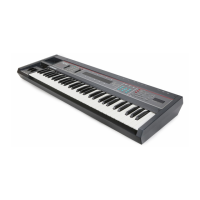SQ-80 — Musician's Manual
[MODES] MODES PAGE
Controls Glide, Sync, AM, and Mono Modes, as well as Voice, Envelope and Oscillator Restart
Modes.
( Inactive Buttons appear in White )
All of the Parameters on this Page are part of the
Program (or patch), and will apply only to the selected
Program.
ACTIVE CONTROLS:
1. SYNC
Syncs the phase of
Oscillator 2 to that of Oscillator 1, In other words, whenever OSC1 finishes
playing one complete cycle of its waveform and begins another,
OSC 2 will reset to the beginning
of its cycle, whether the previous cycle is complete or not.
This produces the popular "Hard Sync" effect, which can be similar to a Filter sweep. The effect
is most noticeable when the Frequency of
Oscillator 2 is varied, or modulated. Sync will tend
to produce unpredictable results when used with Transient Attack or Inharmonic Loop Waves.
2.
AM — Amplitude Modulation.
When ON, the Amplitude of Oscillator 1 modulates the Amplitude of Oscillator 2. OSC 2's
Amplitude Envelope will be ignored. This results in the creation of "Sideband" frequencies at the
sum and difference of the frequencies being played by the two Oscillators.
When
OSC 1 and OSC 2 are tuned to simple intervals of each other (such as octaves or fifths,
etc.),
AM Mode can produce FM-like enharmonics, for bell sounds, etc. When the Oscillators
are tuned to more complex intervals, the effect is more extreme. Since the Amplitude o
Oscillator 2 is no longer being controlled by DCA 2, you must use DCA 4 and ENV 4 to control
the volume of the Sound.
3.
MONO
In MONO mode the SQ-80 behaves like a classic one-voice Monophonic synth. It is useful with
lead-type sounds where chords are not necessary or desirable. With
MONO mode ON, only one
68 Section 3 — Voice Programming

